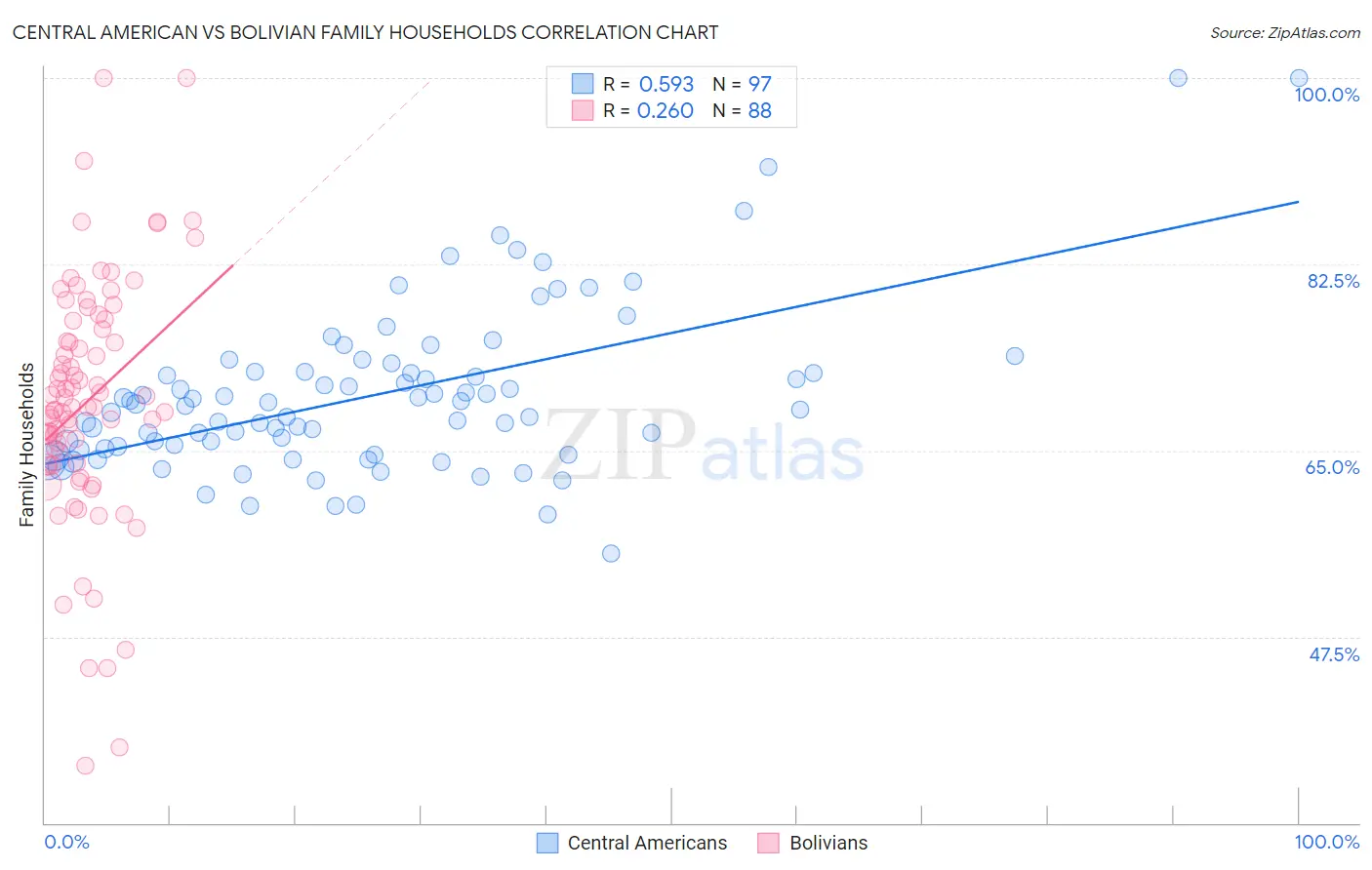Central American vs Bolivian Family Households
COMPARE
Central American
Bolivian
Family Households
Family Households Comparison
Central Americans
Bolivians
66.0%
FAMILY HOUSEHOLDS
100.0/ 100
METRIC RATING
62nd/ 347
METRIC RANK
66.5%
FAMILY HOUSEHOLDS
100.0/ 100
METRIC RATING
47th/ 347
METRIC RANK
Central American vs Bolivian Family Households Correlation Chart
The statistical analysis conducted on geographies consisting of 504,084,166 people shows a substantial positive correlation between the proportion of Central Americans and percentage of family households in the United States with a correlation coefficient (R) of 0.593 and weighted average of 66.0%. Similarly, the statistical analysis conducted on geographies consisting of 184,628,552 people shows a weak positive correlation between the proportion of Bolivians and percentage of family households in the United States with a correlation coefficient (R) of 0.260 and weighted average of 66.5%, a difference of 0.69%.

Family Households Correlation Summary
| Measurement | Central American | Bolivian |
| Minimum | 55.3% | 35.4% |
| Maximum | 100.0% | 100.0% |
| Range | 44.7% | 64.6% |
| Mean | 70.2% | 69.6% |
| Median | 69.2% | 69.1% |
| Interquartile 25% (IQ1) | 65.1% | 63.8% |
| Interquartile 75% (IQ3) | 72.4% | 76.8% |
| Interquartile Range (IQR) | 7.3% | 13.1% |
| Standard Deviation (Sample) | 7.8% | 11.6% |
| Standard Deviation (Population) | 7.8% | 11.5% |
Demographics Similar to Central Americans and Bolivians by Family Households
In terms of family households, the demographic groups most similar to Central Americans are Danish (66.0%, a difference of 0.030%), Immigrants from Indonesia (66.0%, a difference of 0.040%), South American (66.0%, a difference of 0.050%), Immigrants from Korea (66.0%, a difference of 0.060%), and Immigrants from Asia (66.1%, a difference of 0.080%). Similarly, the demographic groups most similar to Bolivians are Immigrants from Venezuela (66.4%, a difference of 0.020%), Arapaho (66.5%, a difference of 0.030%), Venezuelan (66.5%, a difference of 0.050%), Asian (66.5%, a difference of 0.070%), and Immigrants from South Central Asia (66.4%, a difference of 0.070%).
| Demographics | Rating | Rank | Family Households |
| Asians | 100.0 /100 | #44 | Exceptional 66.5% |
| Venezuelans | 100.0 /100 | #45 | Exceptional 66.5% |
| Arapaho | 100.0 /100 | #46 | Exceptional 66.5% |
| Bolivians | 100.0 /100 | #47 | Exceptional 66.5% |
| Immigrants | Venezuela | 100.0 /100 | #48 | Exceptional 66.4% |
| Immigrants | South Central Asia | 100.0 /100 | #49 | Exceptional 66.4% |
| Navajo | 100.0 /100 | #50 | Exceptional 66.4% |
| Natives/Alaskans | 100.0 /100 | #51 | Exceptional 66.4% |
| Colombians | 100.0 /100 | #52 | Exceptional 66.3% |
| Afghans | 100.0 /100 | #53 | Exceptional 66.3% |
| Immigrants | Colombia | 100.0 /100 | #54 | Exceptional 66.3% |
| Immigrants | Immigrants | 100.0 /100 | #55 | Exceptional 66.1% |
| Immigrants | Hong Kong | 100.0 /100 | #56 | Exceptional 66.1% |
| Pennsylvania Germans | 100.0 /100 | #57 | Exceptional 66.1% |
| Immigrants | Asia | 100.0 /100 | #58 | Exceptional 66.1% |
| Immigrants | Korea | 100.0 /100 | #59 | Exceptional 66.0% |
| South Americans | 100.0 /100 | #60 | Exceptional 66.0% |
| Danes | 100.0 /100 | #61 | Exceptional 66.0% |
| Central Americans | 100.0 /100 | #62 | Exceptional 66.0% |
| Immigrants | Indonesia | 100.0 /100 | #63 | Exceptional 66.0% |
| Pima | 99.9 /100 | #64 | Exceptional 65.9% |